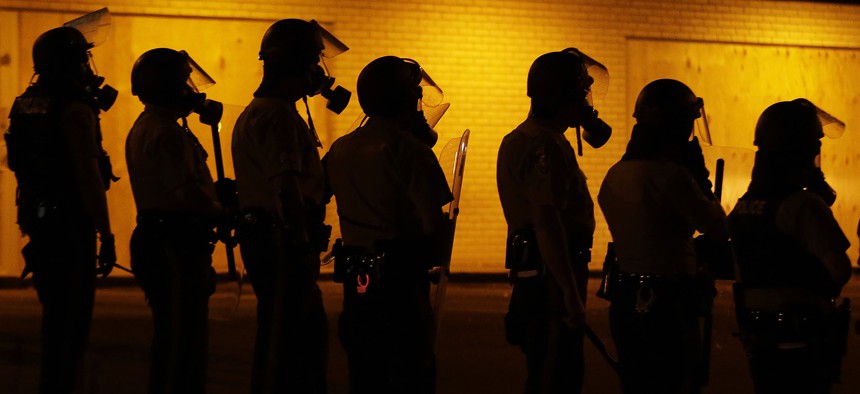What Mayors Can Do to Manage a Crisis of Ferguson Proportions

Police wait to advance after tear gas was used to disperse a crowd during a protest for Michael Brown, who was killed by a police officer on Aug. 9, in Ferguson, Mo. Charlie Riedel / AP File Photo
At their annual conference, African-American mayors are told that most cities lack effective crisis-management teams.
ARLINGTON, Va. — It was seen in Cleveland, Ohio, and in Ferguson, Missouri, and then most recently, Baltimore, Maryland.
Opaque police forces, running their departments like lockboxes, failing to engage their African-American communities only for broken trust to beget ultimate tragedy—deaths like Tamir Rice’s, Michael Brown’s and Freddie Gray’s, and the unrest and protests that followed them.
Without effective community policing, Mayor Patrick Green’s city of Normandy, Missouri—located just down the road from Ferguson—couldn’t have hoped to avoid a spillover of violence like it did.
“Someone in Missouri in the city of Ferguson did not demand accountability from their police department, from their administration, and that put the city legally in liability,” Green told a hotel conference room full of mayors Thursday afternoon. “It put someone, a citizen, in the grave.”
Instead, Normandy’s first black mayor advised attendees of the African American Mayors Association 2015 annual conference to “go to the mountain, folks.” The city holds town hall meetings with police to inform its neighborhoods because “no one shows up for city hall meetings,” Green said, and now no one can blame officials for lack of transparency.
While town halls are important, U.S. Department of Justice Assistant Attorney General Vanita Gupta recommended larger cities consider creating decisionmaking community police commissions with representatives from among youth and civil rights organizations, police unions and philanthropic and faith-based institutions—all selected by mayors.
Cleveland is implementing just such a commission as part of its settlement with Gupta’s Civil Rights Division, which is trying to rebuild eroded trust—often for the first time—between law enforcement and the communities they serve across all its current interventions.
The “structured, institutionalized mechanism” helps civilians own part of and, thus, buy into their police department, and mayors are best positioned to advance them, Gupta told the conference.
“Community policing is not a 40-hour course that law enforcement does; it really is an ethos,” she said. “It’s a philosophy of policing that infuses almost every police practice in terms of transparency, accountability, data collection, bias policing.”
Cities and townships should still have a crisis-management playbook approved by their police department, said consultant John Rowley, even if they can’t afford a commission.
Ideally that entails establishing a mayoral crisis team consisting of a recorder, researcher, outside adviser, attorney, and press secretary, but towns without the budgets for that should designate those roles among their staffs.
An adviser could be a political consultant, Rowley said, or a trusted confidant or spouse because “crises are emotional and we all need perspective.”
Rest assured, in a crisis like Ferguson’s, the team will make or break the situation, he said, adding that most mayors lack them.
“This may be the most divisive, nitroglycerine-like political issue out there,” Rowley said. “I’ve never seen anything where there’s a 40- and 50-point difference between white Americans and black Americans on anything like use of force in the police and whether they go too far.”
The issue defies party lines too, and simply equipping police departments with body cameras is no substitute for developing relationships that humanize officers and the people they protect, “Effective Community Policing” panelists agreed.
Body cameras were not mandated in Cleveland’s settlement with the federal government, but only because the city is already adopting them comporting with the Justice Department’s recently released best practices.
On May 1, the department announced $20 million in grants would be made available to local police departments for the purchase of body cameras, pending congressional approval.
“I think body cameras are useful,” Gupta said. “They can be very important toward building sense of transparency, but I absolutely think it is a mistake to think that they’re a panacea.”
Many community leaders pushed for cameras in the wake of Ferguson, she said, but Eric Garner’s death while in custody of the New York Police Department “dispelled some of the sense that body cameras were going to be the solution.”
And as Karen Freeman-Wilson, the mayor of Gary, Indiana, acknowledged: “The reality is body cameras are used after the fact.”
Freeman-Wilson would like to see a panel of mayors assembled that can advise cities on community policing issues privately.
“Community policing is not just a program,” she said. “It is a way that you do business and engage regularly with the community so that when a tragedy happens—and it can happen in any community; no one should ever feel that they are immune—there is an underlying level of trust there.”
The challenge for St. Louis County, Missouri, is there are 91 municipalities served by 58 police departments, each with their own responsibilities.
Swearing officers in with guns gives them power and the ability to make choices, but local governments must still provide oversight and ensure they’re aware of community culture, housing occupancy and code enforcement, Green said.
“We are the social engineers, the black mayors, of our African-American communities,” he said. “It starts with us.”
NEXT STORY: Cincinnati Takes Big Step Forward to Improve Its Municipal Performance






